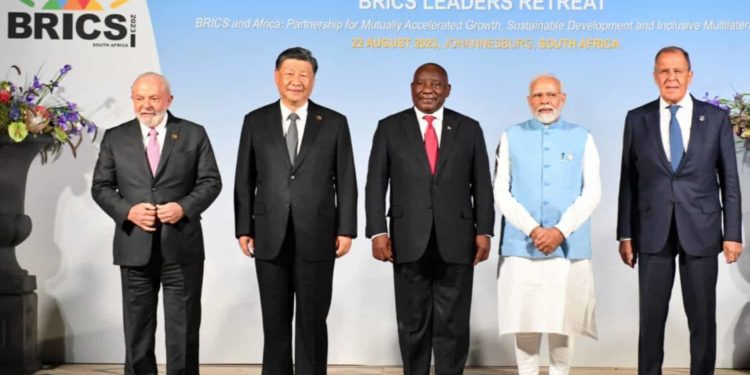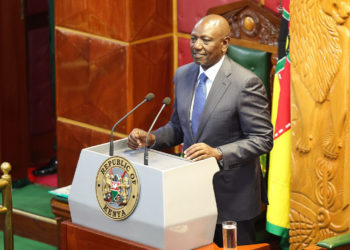Around three decades ago, the world was divided into two dominant camps during the Cold War, which paved the way for the ascendance of the United States’ capitalist system and the Soviet Union’s communist regime. Today, the world has found itself in the midst of a new global transformation known as BRICS, which can be seen as a response from Russia and China to what they perceive as an increasingly assertive United States. This new world order is characterized by rising ideological tensions, geopolitical manoeuvring, indirect conflicts, and an ongoing struggle for global influence.
Read more: The Power of The US Dollar
In this article, “East allies” refer to nations in Eastern Europe, the Middle East, East Asia, and Southeast Asia, while “West allies” encompass Western European countries such as France, Germany, the United Kingdom, Spain, Italy, along with North American nations like the United States, Canada, Mexico, and Oceania countries like Australia and New Zealand. However, it is crucial to acknowledge that the terms “East” and “West” are not rigid categories; they shift based on cultural, historical, and geopolitical contexts. Moreover, the concept of ‘East’ and ‘West’ has been significantly blurred by globalization and interconnectedness.
The BRICS alliance, initially formed in 2009 by Brazil, Russia, India, and China, with the inclusion of South Africa in 2010, has recently demonstrated renewed vigour. The 3-day BRICS 15th summit, held in Johannesburg from 22-24th August 2023, serves as a compelling testament to the rekindled momentum towards shifting away from the old world order to a new one. This resurgence is largely a response to Russia’s growing isolation stemming from Western sanctions imposed in the aftermath of the Ukraine conflict. During the historic summit, the bloc agreed to admit 6 more states, which are Argentina, Ethiopia, Egypt, Iran, Saudi Arabia and UAE, by Jan 2024, with an additional 22 states citing their interest in joining the organization.
Comprising pioneer member states—Brazil, India, South Africa, China, and Russia—the BRICS bloc engaged in extensive deliberations. They addressed a range of critical issues, including reinforcing the multilateral trading system centred on the World Trade Organization (WTO) theme while resisting attempts to create exclusive blocs. The summit also emphasized the necessity of transitioning toward a low-carbon, climate-resilient future, considering diverse national circumstances. Furthermore, leaders underscored the importance of enhancing information exchanges, technological cooperation, unity, and upholding the principles of openness, inclusivity, cooperation, and mutually beneficial outcomes. They also expressed the need to expedite BRICS’ expansion and pursue global governance reform in an inclusive, equitable, and rational manner, including the transparent election of global institutions where institutions like the World Bank and the International Monetary Fund (IMF) have failed to prove or exercise such democratic process. It is however noteworthy that the BRICS members highlighted that the New Development Bank, while established, is not meant to replace existing international financial institutions. Rather, it is designed to complement these organizations, reflecting BRICS’ vision of a reformed World Bank where members possess voting rights proportional to their economic contributions, with staff representing a geographically diverse range of nations. Despite the shared desire for peace articulated by all BRICS leaders, the summit notably refrained from offering direct criticism of Russia’s actions in Ukraine. This omission coincided with President Vladimir Putin’s remote participation, a strategic move likely aimed at avoiding potential legal repercussions.
Read more: Exploring New Frontiers: The Implications of Putin Hosting African Leaders in Russia
Another significant topic discussed during the summit revolved around the expansion of BRICS to encompass emerging markets and developing countries. However, this expansion has brought Africa into another instance of geopolitical division. It can be likened to a modern version of the historical “scramble for Africa” seen during the pre-colonial era, or even the strategy of “divide and rule” implemented during colonial times.
BRICS’ interest in including the African continent in its expansion strategy is influenced by several key factors. Firstly, African countries possess substantial voting power within the United Nations, accounting for approximately 28.0 per cent of all votes in the General Assembly. This significant representation positions Africa as one of the largest regional blocs in the UN. The principle of “one member, one vote” in the UN General Assembly holds symbolic significance and serves as an important indicator of global sentiment. It also holds considerable moral influence, serving as a tool that major powers can use to either support or oppose resolutions. Thus, by diminishing this extensive African representation in the UN, the power dynamics that Western nations utilize to drive policies unfavourable to BRICS allies can be curtailed.
Secondly, Africa possesses extensive reserves of vital raw minerals, particularly cobalt and nickel, which are scarcely found elsewhere in the world. These minerals are pivotal for the development of cutting-edge technologies like smart home appliances, phones, and electric vehicles. The reliance on cobalt, mainly concentrated in the Democratic Republic of Congo, is particularly pronounced in the production of chips. This geographical advantage bolsters Africa’s standing as a key player in the global technology landscape.
Thirdly, Africa is characterized by the fastest-growing youth population worldwide. By 2030, it is projected that young Africans will make up 42.0 per cent of the global youth population and 75.0 per cent of those under the age of 35 within the continent. This demographic phenomenon presents a significant opportunity for advancements in education, technology, human capital development, and the labour force.
Fourthly, the continent boasts abundant green resources suitable for scaling up alternative energy solutions, encompassing both renewable and non-renewable sources. This contributes to global sustainability goals and aligns with the shift towards cleaner energy alternatives.
Fifth, Africa is a key player in the realm of oil and gas reserves, presenting an alternative to the common reserves found in Russia and the Middle East, including countries like Algeria, Nigeria, and Angola—also members of the Organization of the Petroleum Exporting Countries (OPEC).
Read more: President William Ruto Appealed for Equality at The New Global Financial Pact Summit in Paris
Sixth, the strategic positioning of major sea routes, such as those along the Red Sea, which intersects northeastern Africa and links it to the Indian Ocean, holds significant trade value, constituting approximately 10.0 per cent of annual global trade. This has led to diplomatic and economic efforts by Russia, including its engagement with Egypt, to capitalize on this route. China’s Maritime Silk Road initiative aims to bolster port infrastructure within Indian Ocean coastal countries such as Djibouti, Mombasa, Lamu in Kenya, Dar es Salaam, and more.
China’s influence in the continent has also grown considerably within the past decade due to its ability to offer competitive products that are cost-effective and efficient. Over 60.0 per cent of Africa’s imports are now sourced from China, primarily due to perceived cost advantages over European and American products. Moreover, China’s diplomatic and commercial endeavours have succeeded in attracting African countries through initiatives like the Forum on China-Africa Cooperation. This strategy serves to counter the influence of the United States, which attempts to leverage its relationships within the European Union to shape African trade.
Another recent courtship engagement of Africa by the BRICS was seen at the Africa-Russia summit held in St. Petersburg in July 2023, where discussions included Russia’s proposal for free grain imports to African states. The substantial deliberations between Russia and China—both significant players within BRICS—underscore a noteworthy shift in African perspectives, encouraging nations to reconsider their options when considering joining this bloc.
However, the trajectory of this pact is not without its challenges, unveiling a complexity inherent in this international coalition. Notably, there’s a growing veil of uncertainty encircling the bloc. Understandably, the confusion about BRICS’ institutional framework is becoming more pronounced. The absence of a formal headquarters, secretariat, or binding treaty since its establishment in 2010 contributes to this murkiness. It is important to acknowledge that the bloc does possess a formal institution shared among its members – the New Development Bank.
Additionally, tensions are simmering between existing member states and those newly admitted to the alliance. For instance, the friction between Egypt and Ethiopia stems from conflicting interests over the construction of a colossal hydroelectric dam along the Nile River. Likewise, longstanding diplomatic and military hostilities between China and India, as well as between Iran and Saudi Arabia, continue to fuel concerns. Notably, these hostilities have played out in Yemen through a prolonged proxy war and similar conflicts.
Another cause for concern lies in Russia and China’s curbing of information dissemination, especially in matters concerning their own development trajectories. This trend was evident during the initial stages of the COVID-19 outbreak, where China’s authorities impeded the World Health Organization and other foreign investigators from delving into the origins and propagation of the virus from Wuhan.
Equally perplexing is the nomenclature of BRICS itself. The name, while incorporating the acronym of its five major constituent countries, fails to reflect a cooperative essence or unified purpose. When compared to other international blocs with more evocative names, such as the European Union (EU) or the African Union (AU), the term “BRICS” lacks the emotional resonance that comes with a name that signifies a comprehensive sense of unity, shared destiny, and a commitment to common values. The absence of a name that encapsulates the spirit of collaboration and unity could potentially weaken the perception of the alliance’s collective purpose, hindering its ability to project a coherent and compelling narrative to the international community. This further provokes questions about whether the acronym will be adjusted as the bloc expands its membership or whether a renaming might be in the offing to mirror the evolving composition and ambitions of the group.
However, in as much as these powerful nations are seeking to draw a line between the East and west preference, they are having some kind of cordial mutual relationship. Notably, Eastern Europe continues to engage in oil and gas trade relations with Russia, and recent discussions between the USA and China, exemplified by meetings between USA President Joe Biden and Chinese President Xi Jinping, accompanied by treaty signings, attest to a more positive and stable influence of the BRICS bloc on international affairs. Moreover, China’s robust demand for seafood from Japan, making it the largest seafood buyer, underscores the intertwining nature of economies.
From an African standpoint, careful steps must be taken when considering BRICS membership. While the alliance appears promising on paper, it has yet to manifest substantial outcomes beyond convening meetings and expanding its membership roster. The potential of BRICS hinges on the group’s ability to translate its objectives into tangible alternatives that address the existing geopolitical, trade, economic, and social challenges. Without such substantive actions, the risk looms that BRICS might inadvertently perpetuate a “divide and conquer” paradigm, resembling the power dynamics observed in numerous proxy conflicts and militaristic pacts worldwide, where nations shift allegiances opportunistically.
To chart a coherent path forward, African nations should unite in a common pursuit of cooperative efforts and pan-African principles. The emphasis should be on bolstering industrialization, enhancing transportation connectivity to enable a streamlined and efficient supply chain for goods and services, fostering the development of energy infrastructure, amplifying youth employment opportunities within the continent, and shifting the focus away from seeking refuge and opportunities in more developed nations. This transition necessitates an enhanced healthcare system and educational advancements that cater to innovation, technology, science, engineering, economics, and medicine within emerging markets. Facilitating open borders to facilitate smooth trade transactions should take precedence over fostering minor regional organizations that inadvertently hinder these exchanges. Notably, frequent internal conflicts within these regional pacts and the personal interferences of the respective member state leaders often exert a detrimental influence on collective decisions. Examples of such regional organizations dividing the continent include the Southern Africa Development Community (SADC) in the Southern region, the Common Market for Eastern and Southern Africa (COMESA) connecting the southern and eastern regions, the Economic Community of West African States (ECOWAS) in the western Africa, the Economic Community of Central African States (ECCAS) in central Africa, the Arab Maghreb Union (AMU) in North Africa, and the Intergovernmental Authority for Development (IGAD) in the Horn of Africa. Africa should purposefully foster strategic international and geopolitical partnerships, whether originating from the West or the East, that cultivate principles conducive to unity and mutual growth while vigilantly avoiding divisive tactics that breed animosity and discord within the continent.
Email your news TIPS to editor@thesharpdaily.com


















